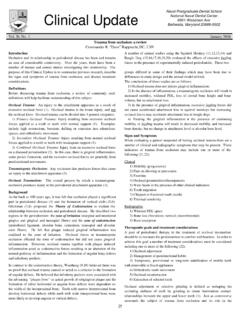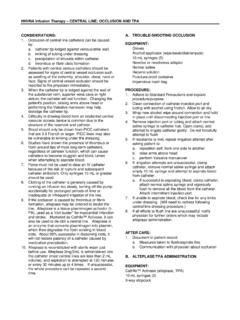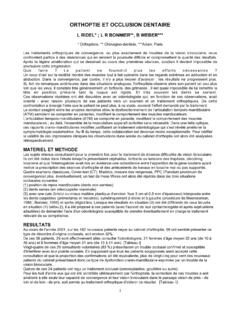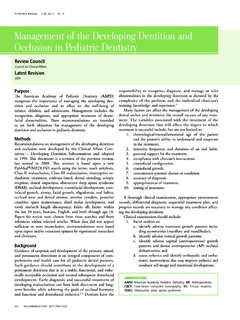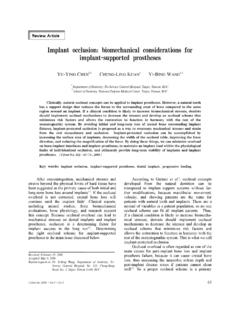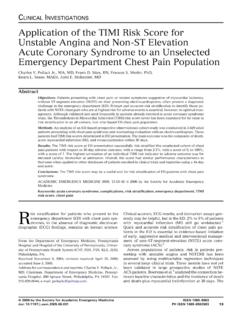Transcription of OCCLUSION IN COMPLETE DENTURES - 4everlearning.com
1 1 OCCLUSION IN COMPLETE DENTURES C P Owen Introduction OCCLUSION has been described as the most important subject in all the disciplines of dentistry, and for good reason, because the way the teeth come together, and function together, is as important to most of us now as it was to our ancestors, who lived on diets much more difficult to cope with. When, as dentists, we are faced with the problem of replacing occlusal surfaces, either by restorations in natural teeth, or replacement of some or all of the teeth, then a thorough knowledge of the way teeth come together and function together, is essential. OCCLUSION has unfortunately also been described as one of the most confusing subjects in all the disciplines of dentistry (mostly by each generation of dental students).
2 Attempts to understand OCCLUSION have ranged from the mechanical, mathematical and geometrical analysis of tooth contact and jaw movement, to the biological and functional analyses based on the behaviour of natural dentitions under different environmental (mostly dietary) conditions. All of these analyses have their place but they need to be brought together into a unified concept, and this is rarely done. However, there are rational ways to study OCCLUSION , and studying OCCLUSION in COMPLETE DENTURES is a good starting point, because of the need to place an entire dentition within a system so that the edentulous patient can once again function with the minimum of discomfort and the maximum possible efficiency.
3 Natural OCCLUSION and artificial OCCLUSION Development of the OCCLUSION The evolution and development of the dentition and temporomandibular joint is a useful study in that it gives us clues as to how our present dentition functions. Mammals evolved from a group of mammal-like reptiles about 280 - 190 million years ago. Reptiles cannot bring their upper and lower teeth together and cannot chew; their teeth cannot move because they are ankylosed. But by the time the earliest known mammal had evolved, these now had two sets of dentitions, and the upper and lower teeth could be occluded. The development of a joint that could allow lateral movements, allowed the newly evolved mammalian cheek teeth to come into a definite occlusal relationship.
4 The earliest known mammal had as precise a relationship between upper and lower molars as nearly all known mammals, the upper molars lying just behind the equivalent lower molars. Diphyodonty (one replacement set, two dentitions) probably evolved as a result of the increasing efficiency of the dentition created by the use and wear of teeth that would shear against each other. On eruption, the (unworn) teeth do not fit accurately together and so work inefficiently. There is no point in producing a succession of such inefficient dentitions, as every newly erupted molar, because of its high unworn cusps, would have disrupted the smoothly efficient shearing edges which are created by attrition (see Figures 1 and 2).
5 2 Figure 1: Early wear of teeth in a gorilla Figure 2: Early wear of teeth in a human who lived about 10,000 years ago. The wear has produced a sharp edge of enamel on the first molar, which is very efficient for shearing and cutting of coarse food, and the flatter occlusal surface allows for efficient grinding. This person was a coastal-dweller, and lived on a variety of foods, including fish and crustaceans. The other teeth still have enamel occlusal surfaces. A deciduous dentition also helps to solve the problem of providing a child with a most effective masticatory apparatus appropriate to their needs at that time, and consistent with the space available in the jaws.
6 The potential functional weakness of a transition period is minimised by the sequence of events: when the central incisors are lost, the deciduous lateral incisors and canines can be used to incise food, whilst loss of the deciduous molars does not prevent crushing and grinding because the first permanent molars are already in place. The allied development of a gomphosis (periodontal ligament type attachment) allows the position of each tooth to be adjusted after eruption, in response to forces produced during chewing, so that it normally ends up in the most efficient position. This adjustment can only take place within very narrow limits, so that it seems that environmental forces provide a fine adjustment for the basic developmental controls that ensure that the jaws, and the teeth within the jaws, develop in the correct relationship.
7 Features of natural occlusions In the unworn dentition, which used to occur only soon after the teeth erupted and before they were worn down by the diet, the pathways the teeth take are dependent on the cusps and morphology of the occlusal surfaces of the teeth, as well as on the morphology of the joints. In chewing, the lower teeth move across the uppers, passing through the intercuspal position, usually without stopping. The intercuspal position is used during chewing, swallowing, and during deliberate clenching of the teeth. 3 During function, the presence of unworn cusps usually results in a separation of the teeth on one side, whilst the teeth contact on the other side of the arch.
8 This is observed most obviously during lateral movements but also occurs in protrusive movements when the anterior teeth contact and the posteriors do not. These occlusal and articulating relationships are those of what has become called ideal OCCLUSION by those dentists who have used mechanistic philosophies and explanations, based on observations of how things are rather than on why things are. There are those, however, who realise that a biological explanation should be sought for the way in which teeth come together and function under different conditions. And it is the different conditions that have caused the problems. Under the influence of an abrasive diet, the majority of natural dentitions display no malocclusion, largely because of the wear that takes place.
9 However, since the Industrial Revolution and the refinement of foodstuffs and their preparation, human dentitions no longer function as it appears they should . The requirement that teeth that are lost be replaced has made the dental profession aware of the difficulties encountered in replacing the complex morphology of an unworn tooth. That requirement made dentists look minutely at the form of each tooth, and more especially at the form of its occluding surface in order to make replacement teeth fit into, and function with, the remaining teeth. It is from this perspective that the concept of ideal OCCLUSION has arisen: but it really describes how teeth relate to each other after they have erupted but before they have worn.
10 Although this lack of wear in the dentition can lead to misunderstandings as to its natural function, the fact remains that we are faced with repairing and replacing teeth within such an unnatural environment. Further, we are faced with COMPLETE dentitions that do not function harmoniously in terms of the masticatory system as a whole (which includes muscles and joints). It is, therefore, necessary to understand how unworn dentitions are supposed to function, provided one does not lose sight of the fact that they were in fact meant to wear. Hence concepts such as protrusive OCCLUSION and canine lift may have no real biological meaning. From the biological point of view there seems little justification for building these concepts into a reconstructed dentition, especially when the materials used are by their nature incapable of wear.


